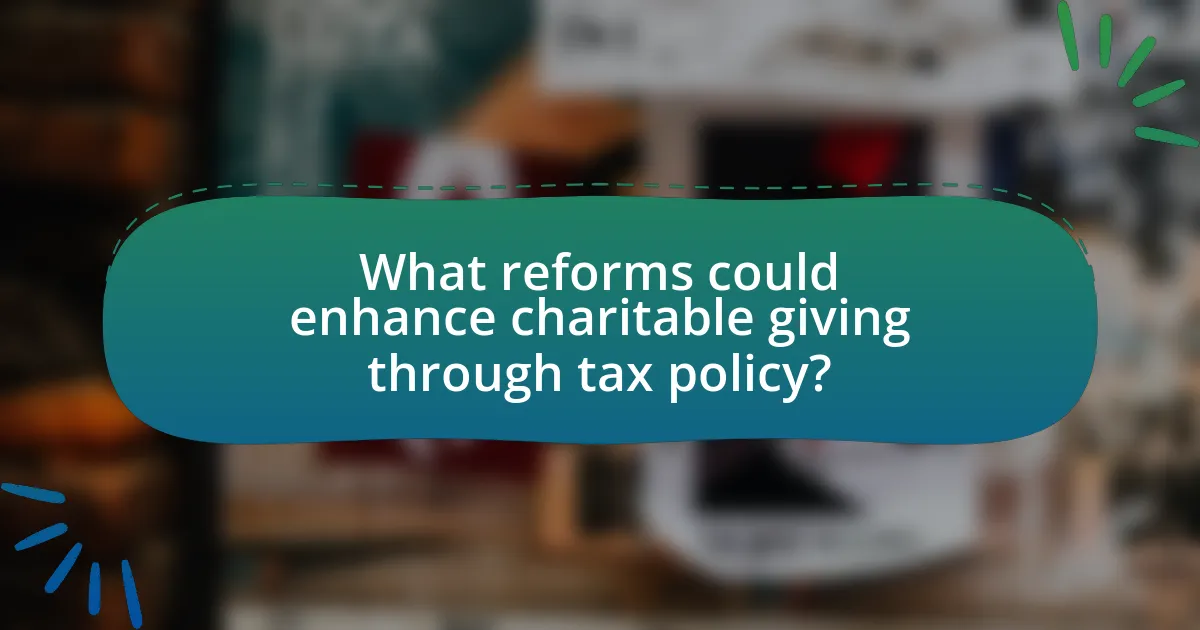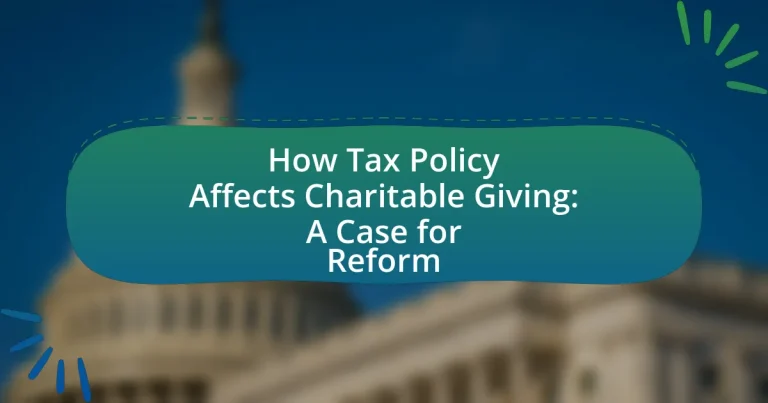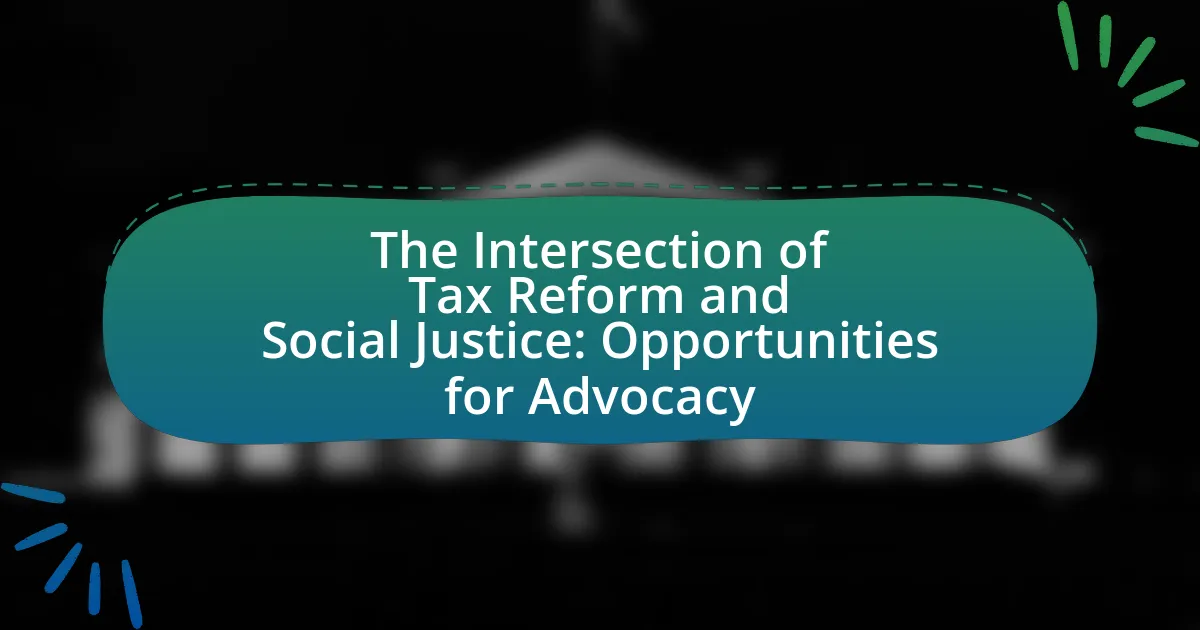The article examines how tax policy influences charitable giving, highlighting the financial incentives provided by tax deductions and credits that encourage donations from individuals and corporations. It discusses key components of tax policy, such as the impact of the Tax Cuts and Jobs Act of 2017 on charitable contributions, and explores the role of tax deductions and credits in motivating philanthropy. The article also addresses misconceptions about tax benefits, current challenges in tax policy, and disparities in charitable giving across different income groups. Additionally, it proposes potential reforms to enhance charitable giving through tax policy, drawing comparisons with successful international practices.

How does tax policy influence charitable giving?
Tax policy significantly influences charitable giving by providing financial incentives, such as tax deductions for donations. These deductions reduce the effective cost of giving, encouraging individuals and corporations to contribute more to charitable organizations. For instance, the Tax Cuts and Jobs Act of 2017 increased the standard deduction, which led to a decrease in itemized deductions, resulting in a decline in charitable contributions by an estimated $17 billion in 2018, according to the Lilly Family School of Philanthropy. This demonstrates that changes in tax policy directly impact the level of charitable giving, as the financial benefits associated with donations can motivate or deter potential donors.
What are the key components of tax policy that affect donations?
The key components of tax policy that affect donations include tax deductions for charitable contributions, the tax treatment of nonprofit organizations, and the overall tax rate structure. Tax deductions incentivize individuals and corporations to donate by allowing them to reduce their taxable income, which can lead to increased charitable giving. For instance, the Internal Revenue Service (IRS) allows taxpayers to deduct contributions to qualified charitable organizations, effectively lowering their tax burden. Additionally, the tax-exempt status of nonprofits under Section 501(c)(3) of the Internal Revenue Code enables these organizations to operate without paying federal income tax, which can enhance their capacity to receive and utilize donations effectively. Lastly, the overall tax rate structure influences disposable income levels; lower tax rates can increase the amount of money available for donations, while higher rates may reduce disposable income and, consequently, charitable contributions.
How do tax deductions for charitable contributions work?
Tax deductions for charitable contributions allow taxpayers to reduce their taxable income by the amount donated to qualified charitable organizations. When individuals itemize their deductions on their tax returns, they can deduct contributions made to IRS-recognized charities, which can lower their overall tax liability. For example, in the United States, taxpayers can deduct cash contributions up to 60% of their adjusted gross income, while contributions of property may have different limits based on fair market value. This incentivizes charitable giving by providing a financial benefit, thereby encouraging donations to nonprofits and other charitable entities.
What role do tax credits play in encouraging philanthropy?
Tax credits significantly incentivize philanthropy by reducing the financial burden on donors, making charitable contributions more appealing. When individuals or corporations receive tax credits for their donations, they effectively lower their taxable income, which can lead to substantial tax savings. For instance, a study by the National Bureau of Economic Research found that a 1% increase in the value of tax deductions for charitable giving can lead to a 1.2% increase in donations. This demonstrates that tax credits not only encourage higher levels of giving but also stimulate a culture of philanthropy by making it financially advantageous for donors to support charitable organizations.
Why is understanding tax policy important for donors?
Understanding tax policy is crucial for donors because it directly influences the financial benefits they receive from their charitable contributions. Tax deductions for donations can significantly reduce a donor’s taxable income, thereby incentivizing charitable giving. For instance, the Tax Cuts and Jobs Act of 2017 raised the standard deduction, which led to a decrease in itemized deductions for many taxpayers, ultimately affecting their willingness to donate. This demonstrates that awareness of tax policy enables donors to maximize their contributions while minimizing their tax liabilities, thereby enhancing the overall impact of their philanthropy.
How can tax policy impact the decision-making process for potential donors?
Tax policy significantly influences the decision-making process for potential donors by affecting the financial incentives associated with charitable contributions. When tax deductions for donations are available, individuals are more likely to contribute, as they can reduce their taxable income, effectively lowering the cost of giving. For instance, a study by the National Bureau of Economic Research found that a 1% increase in the tax price of giving leads to a 1.2% decrease in donations, demonstrating the sensitivity of donor behavior to tax incentives. Therefore, favorable tax policies can enhance charitable giving by making it more financially attractive for donors.
What misconceptions exist about tax benefits and charitable giving?
Misconceptions about tax benefits and charitable giving include the belief that only wealthy individuals can benefit from tax deductions for donations. In reality, taxpayers at all income levels can receive tax benefits, as charitable contributions can be deducted from taxable income if they itemize deductions. Another misconception is that all donations are fully deductible; however, only donations to qualified organizations are eligible for deductions, and certain limits apply based on the donor’s adjusted gross income. Additionally, some people think that tax benefits are the primary motivation for charitable giving, but studies show that emotional and social factors often drive donations more than tax incentives.

What are the current challenges in tax policy related to charitable giving?
Current challenges in tax policy related to charitable giving include the increasing complexity of tax regulations, which can deter potential donors, and the limitations on tax deductions for charitable contributions that disproportionately affect middle and lower-income individuals. The Tax Cuts and Jobs Act of 2017, for example, raised the standard deduction, leading to a significant decrease in the number of taxpayers who itemize deductions, thereby reducing the incentive for many to give charitably. Additionally, the lack of clarity in regulations regarding donor-advised funds and the potential for abuse in these vehicles pose further challenges to effective charitable giving.
How do existing tax policies limit charitable contributions?
Existing tax policies limit charitable contributions primarily through the imposition of caps on deductions and the lack of incentives for non-itemizers. These policies restrict the amount taxpayers can deduct for charitable donations, which can discourage higher levels of giving. For instance, the Tax Cuts and Jobs Act of 2017 increased the standard deduction, resulting in fewer taxpayers itemizing their deductions; this change led to a significant decline in the number of individuals who could benefit from charitable contribution deductions, ultimately reducing overall charitable giving by an estimated $17 billion in 2018 alone.
What are the effects of the standard deduction on itemized charitable deductions?
The standard deduction reduces the number of taxpayers who itemize deductions, including charitable contributions. When taxpayers opt for the standard deduction, they cannot claim itemized deductions, which means they miss out on potential tax benefits associated with charitable giving. According to the Tax Policy Center, the increase in the standard deduction in 2018 led to a significant decline in itemizers, with estimates suggesting that only about 10% of taxpayers itemized in 2021, down from approximately 30% prior to the change. This shift can negatively impact charitable organizations, as fewer taxpayers are incentivized to donate due to the lack of tax benefits associated with itemized deductions.
How do changes in tax rates influence donor behavior?
Changes in tax rates significantly influence donor behavior by altering the financial incentives associated with charitable contributions. When tax rates increase, the after-tax cost of giving rises, often leading to a decrease in donations as individuals may feel less inclined to contribute. Conversely, when tax rates decrease, the after-tax cost of giving falls, which can encourage higher levels of charitable donations. For instance, a study by the National Bureau of Economic Research found that a 1% increase in the tax price of giving can lead to a 0.5% decrease in charitable contributions. This demonstrates that tax policy directly impacts the willingness of individuals to donate, highlighting the importance of tax incentives in promoting charitable giving.
What disparities exist in charitable giving due to tax policy?
Disparities in charitable giving due to tax policy primarily arise from the differences in tax deductions available to high-income versus low-income individuals. High-income earners benefit significantly from itemized deductions, which incentivize larger donations, while low-income individuals often do not itemize and thus miss out on these tax benefits. According to a 2019 report by the Tax Policy Center, nearly 90% of the tax benefits from charitable deductions go to the top 20% of earners, highlighting the inequitable distribution of tax incentives. This creates a situation where wealthier individuals are more likely to contribute larger sums to charities, exacerbating the gap in charitable giving across different income levels.
How does tax policy affect different income groups’ ability to donate?
Tax policy significantly influences different income groups’ ability to donate by determining the tax deductibility of charitable contributions. Higher-income individuals often benefit more from tax deductions, as they can afford to donate larger sums and receive a greater tax reduction, incentivizing their charitable giving. Conversely, lower-income groups may not have the same capacity to donate or may not benefit as much from tax deductions, as their tax liabilities are often lower or nonexistent, which diminishes the incentive to give. For instance, a study by the Urban-Brookings Tax Policy Center found that tax deductions disproportionately favor higher-income households, leading to a disparity in charitable contributions across income levels.
What impact does tax policy have on nonprofit organizations’ funding?
Tax policy significantly influences nonprofit organizations’ funding by affecting the incentives for charitable giving. Specifically, tax deductions for donations encourage individuals and corporations to contribute more to nonprofits, as these deductions reduce the effective cost of giving. For instance, the Tax Policy Center reported that in 2019, charitable contributions amounted to $449 billion, with a substantial portion attributed to the tax deductibility of donations. This demonstrates that favorable tax policies can lead to increased funding for nonprofits, while changes that limit these deductions may result in decreased contributions and financial strain on these organizations.

What reforms could enhance charitable giving through tax policy?
Reforms that could enhance charitable giving through tax policy include increasing the standard deduction, allowing for universal charitable deductions, and providing tax credits for donations. Increasing the standard deduction can incentivize more individuals to donate, as it simplifies the tax process and encourages giving among those who may not itemize deductions. Allowing universal charitable deductions would enable all taxpayers, regardless of income level, to deduct charitable contributions, thus broadening the base of potential donors. Additionally, offering tax credits for donations can provide a direct financial benefit to donors, making charitable giving more appealing. Research indicates that tax incentives significantly influence charitable contributions; for instance, a study by the National Bureau of Economic Research found that a 1% increase in the tax price of giving leads to a 1.2% decrease in donations.
How can tax incentives be redesigned to promote greater giving?
Tax incentives can be redesigned to promote greater giving by increasing the deduction limits for charitable contributions and implementing a universal charitable deduction for all taxpayers. Increasing deduction limits encourages higher donations by allowing individuals to deduct a larger portion of their contributions from taxable income, which has been shown to correlate with increased giving. For instance, a study by the Lilly Family School of Philanthropy found that higher tax incentives lead to a significant increase in charitable donations, particularly among high-income earners. Additionally, a universal charitable deduction would enable non-itemizers to benefit from tax deductions, broadening the base of potential donors and encouraging more individuals to contribute to charitable causes.
What are the potential benefits of expanding tax deductions for all donors?
Expanding tax deductions for all donors can significantly increase charitable contributions. By making tax deductions accessible to a broader range of individuals, more people are incentivized to donate, which can lead to a substantial increase in funding for nonprofit organizations. Research from the Tax Policy Center indicates that tax incentives can boost charitable giving by approximately 20% to 30% among those who itemize deductions. Furthermore, studies show that when tax benefits are available to all donors, including those who do not itemize, overall charitable giving tends to rise, enhancing the financial stability of charities and enabling them to expand their services and outreach.
How might introducing new tax credits stimulate charitable contributions?
Introducing new tax credits can stimulate charitable contributions by providing financial incentives for individuals and corporations to donate. When taxpayers receive a credit for their charitable donations, the effective cost of giving decreases, making it more appealing to contribute. For instance, a study by the National Bureau of Economic Research found that tax incentives can increase charitable giving by as much as 20% among high-income earners. This demonstrates that when tax policies favor donations, they can significantly enhance the overall level of charitable contributions.
What lessons can be learned from other countries’ tax policies on charitable giving?
Countries with favorable tax policies for charitable giving demonstrate that tax incentives can significantly increase donations. For instance, in the United Kingdom, the Gift Aid scheme allows charities to claim back 25% on donations made by taxpayers, effectively boosting the total contribution without additional cost to the donor. This policy has led to a substantial increase in charitable donations, with estimates suggesting that Gift Aid adds billions to the charity sector annually. Similarly, in Canada, the tax credit system encourages donations by providing a tiered credit that increases with the amount donated, resulting in higher overall contributions. These examples illustrate that well-structured tax incentives can enhance charitable giving, suggesting that reforming tax policies to include similar incentives could lead to increased support for nonprofits in other countries.
How do international tax policies compare to those in the United States?
International tax policies often differ significantly from those in the United States, particularly in their treatment of charitable contributions. While the U.S. allows taxpayers to deduct charitable donations from their taxable income, many countries do not offer similar incentives, or they impose stricter limits on deductions. For instance, in the United Kingdom, taxpayers can claim Gift Aid, which allows charities to reclaim tax on donations, but the overall deduction limits are more restrictive compared to the U.S. Furthermore, countries like Germany and France have specific caps on the percentage of income that can be deducted for charitable giving, which contrasts with the more flexible U.S. system. These differences can influence the level of charitable giving in each country, as the tax benefits associated with donations can significantly impact donor behavior.
What successful reforms have been implemented elsewhere that could be adapted?
Successful reforms that could be adapted include the implementation of tax incentives for charitable donations seen in countries like Canada and the United Kingdom. In Canada, the Charitable Donations Tax Credit allows individuals to receive a tax credit of up to 54% on donations, significantly boosting charitable giving. Similarly, the UK offers Gift Aid, which enables charities to claim back 25p for every £1 donated by taxpayers, effectively increasing the value of donations. These models demonstrate that enhanced tax incentives can lead to increased charitable contributions, providing a clear framework for potential adaptation in other jurisdictions.
What practical steps can individuals take to maximize their charitable impact?
Individuals can maximize their charitable impact by strategically selecting organizations that align with their values and assessing their effectiveness. Research indicates that donations to high-performing charities can lead to greater social outcomes; for instance, the Effective Altruism movement emphasizes evidence-based giving, which has shown that targeted donations can significantly improve lives. Additionally, individuals should consider leveraging tax incentives, such as itemizing deductions for charitable contributions, which can enhance their overall giving capacity. Engaging in volunteer work also amplifies impact, as it provides direct support to organizations and fosters community involvement.




